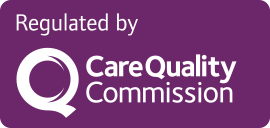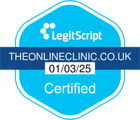Rhinocort Aqueous Nasal Spray
Rhinocort Aqueous Nasal Spray is used for relief from symptoms of seasonal and perennial allergic rhinitis and nasal polyps.
Can I buy Rhinocort Aqueous Nasal Spray online?
The Online Clinic can prescribe this medication following a short consultation on our website. Please click on the button to continue with your free consultation.
What is Rhinocort Aqueous Nasal Spray?
Relief from allergy symptoms due to seasonal and perennial allergic rhinitis (such as a runny, blocked nose that is itchy, and sneezing) or nasal congestion due to polyps can be provided by using Rhinocort Aqueous Nasal Spray. Allergic rhinitis may be seasonal, occurring during a specific season like autumn, or perennial, occurring all year round. Common allergens (material causing the allergy) include tree, plant and grass pollens (seasonal) and pet dander (perennial). The medicine is not for nasal congestion experienced with a common cold.
The active compound in Rhinocort Aqueous Nasal Spray is budesonide. This is a decongestant and classed as a corticosteroid. Specifically, it is a glucocorticosteroid that works on the nasal mucosa (lining of the nose). It acts to reduce inflammation by blocking the action of cells and chemicals involved in the body’s inflammatory response to an allergen.
Rhinocort Aqueous Nasal Spray is a water-based solution for spraying, which is provided in a small glass spray bottle. The spray contains budesonide at a dose of 64 micrograms per spray.
How to use Rhinocort Aqueous Nasal Spray
Rhinocort Aqueous Nasal Spray is for spraying up the nose only. For adults, adolescents, and children age 6 years and older, deliver 2 sprays into each of the nostrils once a day OR 1 spray into each nostril in the morning and evening every day. An adult should guide a child’s treatment. If possible, use the spray before exposure to the allergen causing the symptoms. It may take 1 or 2 weeks of treatment for you to achieve most benefit. The dose may be reduced to 1 spray per nostril per day when the allergy symptoms improve. You should use the medicine for no longer than it is needed.
Detailed instructions on administering Rhinocort Aqueous Nasal Spray are provided in the box. Before first use of the bottle, it must be primed. To do this, shake the bottle gently before removing the cap. Hold the bottle with two fingers resting on the white collar surrounding the nozzle and thumb at the base. Press down on the collar quickly 8 times to prime (fill) the nozzle and deliver a fine mist; replace cap until ready to use.
For each daily dose, blow your nose gently first, shake bottle gently, and take cap off. Insert the tip of the nozzle into nostril and press down on the white collar firmly and quickly while gently sniffing/breathing in. Repeat in the same nostril if you need 2 sprays per nostril, and then repeat again for the other nostril. Wipe away any medicine from the spray tip using a clean tissue before replacing the cap. If the medicine is not used for over 24 hours, then the pump must be primed again. If the nozzle becomes blocked, then remove it and wash in warm water. Rinse, dry and replace the nozzle onto the bottle, and prime it before use.
If spray gets into your eyes or mouth rinse with lots of water. Too much spray on isolated occasions is unlikely to have any effect, but if too much is continually delivered for long periods of time could have adverse effects. If a dose is missed, spray your nostrils as soon as you remember but avoid doubling the dose.
Who can use Rhinocort Aqueous Nasal Spray?
Adults, adolescents and children 6 years of age and older can use Rhinocort Aqueous Nasal Spray. Children below the age of 6 years must not use the spray. Adults supervising children prescribed the spray should first speak with the child’s doctor about use of this spray, particularly if the child may need to use it over long time period. Please note that The Online Clinic does not prescribe for children. If pregnant or breast-feeding, then discuss using the spray before starting treatment.
Rhinocort Aqueous Nasal Spray is not for use by anyone allergic to budesonide or to the spray’s other ingredients. The spray is not for use by those who have nose bleeds, have untreated infections of the nose, infections around the nose, mouth or eye, and ulcers in the nose, had surgery of the nose, or had trauma to the nose until they have recovered. Rhinocort Aqueous Nasal Spray must be used with caution in people with liver problems or have/have had tuberculosis, infections in the air passages, and have/ have had visual disturbances, cataracts or glaucoma. When treatment is continuous and long-term, children’s growth should be monitored and the nose lining (mucosa) should be examined regularly.
Inform your doctor of all medicines that you currently take, have recently taken, and that may be taken in the future. Some medicines may not be recommended when using the spray. If you are currently using a steroid medicine, then taking the spray that is also a steroid may not be advised. Some other certain medicines (such as ketoconazole and itraconazole for fungal infections, the immunosuppressant cyclosporin, some contraceptives, and cobicistat (used in HIV) can increase blood levels of the spray’s active ingredient budesonide and so may not be recommended.
Rhinocort Aqueous Nasal Spray Side Effects
Side effects with a nasal corticosteroid spray are more likely to occur when it is used for prolonged periods and at higher doses than recommended by your doctor, because your natural steroid production by the adrenal glands may be affected. This is why you are advised to use the medicine only for the time that it is needed and at the lowest dose required to control your symptoms.
While uncommon, you can develop a hypersensitivity reaction with Rhinolast Aqueous Nasal Spray, which generally involves the skin with rash, itching, urticaria, dermatitis, and swelling under the skin. Contact your doctor if you experience these symptoms.
Commonly, local reactions can occur in the nostrils, involving nasal irritation, blood in the mucus, and nose bleeds after spraying. Nasal ulcers, perforation of the septum dividing the nostrils, bruising, and blurred vision and other visual disturbances have also been reported. Glaucoma and cataracts and fragile bones may occur, and growth can be delayed in children.
GMC registration number: 4524038

Date: 30 October 2024
Next review: 29 October 2026
All UK registered doctors can have their registration checked on
The Medical Register at the GMC website.







